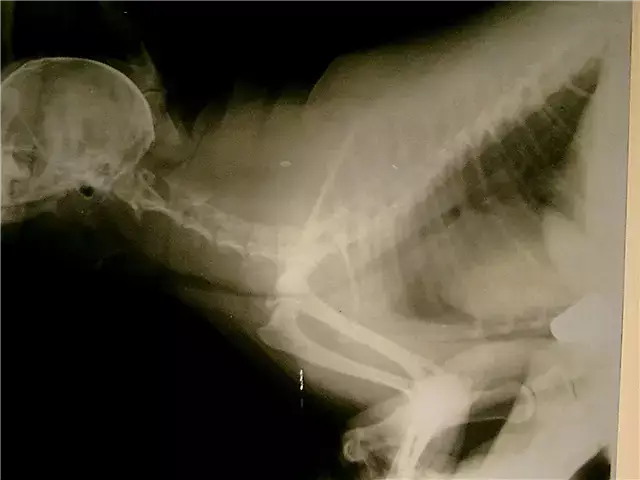- Author Rachel Wainwright [email protected].
- Public 2023-12-15 07:39.
- Last modified 2025-11-02 20:14.
ATG-Fresenius S
Instructions for use:
- 1. Release form and composition
- 2. Indications for use
- 3. Contraindications
- 4. Method of application and dosage
- 5. Side effects
- 6. Special instructions
- 7. Drug interactions
- 8. Terms and conditions of storage
ATG-Fresenius C is an immunosuppressive drug. Heterologic antiserum.
Release form and composition
ATG-Fresenius S is available in the form of a concentrated solution for infusion: transparent or slightly opalescent, colorless or slightly yellowish (5 ml in vials, in a cardboard box of 1 or 10 vials).
Composition of 1 ml of concentrate:
- active substance: anti-thymocytic immunoglobulin - 20 mg;
- auxiliary components: phosphoric acid, sodium dihydrogen phosphate, water for injection.
The drug is obtained from the serum of rabbits immunized with human T-lymphocytes of the Jurkat cell line.
Indications for use
ATG-Fresenius C is used in combination with other immunosuppressants (cyclosporine, prednisone, methylprednisolone, azathioprine) to suppress the immune response in organ transplantation, as well as in acute GCS-resistant graft rejection.
Contraindications
- severe thrombocytopenia (platelet count less than 50 thousand / μl);
- acute infectious diseases of fungal, bacterial and viral origin, resistant to therapy;
- period of pregnancy;
- increased individual sensitivity (including to rabbit proteins).
Method of administration and dosage
ATG-Fresenius C is administered intravenously.
Recommended doses and duration of treatment:
- prevention of transplant rejection after organ transplantation: single dose - 2-5 mg (0.1-0.25 ml) per 1 kg of body weight intravenously; the recommended daily dose is 3-4 mg / kg of body weight. The duration of therapy is from 5 to 14 days, starting from the day of organ transplant;
- acute GCS-resistant graft rejection: intravenously 3-5 mg (0.15-0.25 ml) per 1 kg of body weight per day; the recommended daily dose is 3-4 mg / kg of body weight. The duration of therapy is from 5 to 14 days, starting from the day of complication.
To prepare a solution for intravenous administration, a bottle with a concentrate is diluted in 250-500 ml of isotonic sodium chloride solution. A large vessel should be selected for injection. The prepared solution must be used within 4 hours.
Before the introduction, an intradermal sensitivity test is performed. For allergy testing, use undiluted concentrate. However, if hypersensitivity to rabbit protein is suspected, ATG-Fresenius C is diluted with 0.9% sodium chloride solution in a ratio of 1: 100. For a sample, 0.05 ml of the drug is injected intradermally, preferably in the forearm (in the area of its inner surface). For control, a 0.9% sodium chloride solution is injected into the same place on the other hand.
Based on the developed reaction, the test is evaluated. If hyperemia or edema occurs at the injection site within 15 minutes, and there are no changes at the control injection site, the patient has an increased sensitivity to rabbit proteins. Reactions in both hands indicate generalized hypersensitivity of the patient.
Side effects
During the use of the drug ATG-Fresenius C, general side reactions may occur: dizziness, fever, nausea. Chills and fever with a temperature of 40 ° C and above are rare and disappear in the first few days of therapy.
Serum sickness may develop on day 8-14 of treatment. With mild and reversible symptoms of serum sickness, drug withdrawal is not required.
In rare cases, during intravenous infusion or immediately after its completion, anaphylactic reactions develop with typical symptoms (erythema, hypotension, fever, shortness of breath, edema, wheezing noisy breathing). The risk of anaphylactic shock is greatest in the first 3 days of therapy. With a weak anaphylactic reaction, treatment with the drug can be continued if necessary, while antihistamines are prescribed at the same time. In case of severe reactions that threaten the patient's life, the introduction of ATG-Fresenius C should be suspended and anti-shock therapy should be switched to.
A pronounced decrease in the number of lymphocytes is drug-specific and is associated with the immunosuppressive effect of the drug. Subject to the recommended dosage, cases of granulocytopenia or thrombocytopenia requiring discontinuation of treatment rarely develop.
special instructions
In the first 30 minutes after the administration of ATG-Fresenius C, as well as during the first three days of therapy, the patient should be under the strict supervision of the hospital staff (to exclude the risk of severe allergic reactions).
It has been established that local and systemic tolerance to the drug ATG-Fresenius C improves if antihistamines and / or glucocorticosteroids are used before intravenous administration.
With immunosuppression, the likelihood of developing fungal, viral and bacterial infections increases, therefore, during treatment, it is advisable to carry out concomitant therapy (antifungal and antiviral drugs, antibiotics).
The use of immunosuppressants before or simultaneously with skin allergy tests can cause a negative reaction, even if the patient has hypersensitivity.
During treatment with ATG-Fresenius C, it is necessary to refuse to drive vehicles and engage in other potentially hazardous activities associated with increased concentration of attention and a quick reaction.
Drug interactions
With simultaneous use with other immunosuppressive drugs (cyclosporine, glucocorticosteroids, azathioprine), the likelihood of anemia, thrombocytopenia and infections increases (careful monitoring of patients is required).
During the treatment period, it is forbidden to do live attenuated viral vaccines (other vaccines may cause an insufficient immune response).
ATG-Fresenius C is incompatible pharmaceutically with other drugs. An isotonic sodium chloride solution is used as a solvent.
Terms and conditions of storage
Store at 2-8 ° C in a dark place. Keep out of the reach of children.
Expiration date - 1 year.
Information about the drug is generalized, provided for informational purposes only and does not replace the official instructions. Self-medication is hazardous to health!






